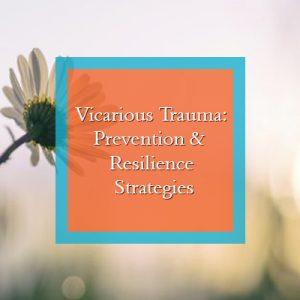Workshop Overview

Both front-line staff and supervisors within the health, social and emergency services sectors are increasingly exposed to the traumatic experiences of high–needs, high-risk clients. Both long-term and short-term exposure to the traumatic experiences of others, for example, addictions, abuse, violence, human suffering, and more can produce a variety of symptoms in the helper themselves. This type of trauma is referred to as “vicarious”, or “secondary” trauma, and the costs to individual and organization can be significant. Vicarious trauma can lead to a negative transformation of the helper’s own sense of safety and well-being and its symptoms are similar to post-traumatic stress disorder (PTSD).
This customized 2-day training will teach the symptoms and risks of vicarious trauma as a critical first step to increasing individual and group resiliency and to building workplace capacity in dealing with this occupational hazard. This training supports staff and managers in enhancing the resiliency factors that help prevent and/or mitigate vicarious trauma at the individual, team and workplace levels.
This is a highly interactive training workshop giving participants an opportunity to learn, reflect and consider how they integrate this information within their jobs and roles now and over time.
Learning Objectives
During this customized training workshop participants will:
- Gain a comprehensive understanding of vicarious trauma (VT)
- Defining VT
- Understanding how it is a result of the nature of the work itself, combined with individual, incident, and workplace risk/resiliency factors
- symptoms of VT/how to identify VT
- Complete a VT self-assessment that indicates a personalized risk and resilience profile specific to VT
- Explore evidence-based resiliency strategies including…
- Awareness of impact
- Self-regulation
- Grounding and self-centering
- Understand trauma triggers and VT
- Safety, trust & connection
- Emotional boundaries
- Containment
- Mindfulness
- Self-care essentials (emotional, physical, psychological, spiritual self-care)
- Consider helpful ways to identify and support someone who may be experiencing VT (helpful do’s and don’ts) to increase team resilience and effective peer support
- Learn an effective critical incident debriefing process (avoid “sliming” or increasing VT risk among colleagues)
- Discover ways to increase vicarious transformation and vicarious resilience
- Create a personalized plan for increasing their resilience and for minimizing the risk for the negative effects of vicarious trauma
By the end of this training, participants will be encouraged to demonstrate how they will apply and integrate their learning in their own unique circumstances and within the workplace in service to preventing VT, minimizing negative effects, and ensuring quality service delivery and good practice with clients. Further benefits of a training of this nature include both team and relationship building. Learners can then skillfully support one another on-the-job.
Expected Outcomes for Participants:
- Greater sense of control
- Less overwhelmed by trauma stories
- Improved trauma event response
- Enhanced feelings of well-being
- Increased knowledge about vicarious trauma
- Have a personalized plan for resilience
Bring this training workshop to your employees and organization.
